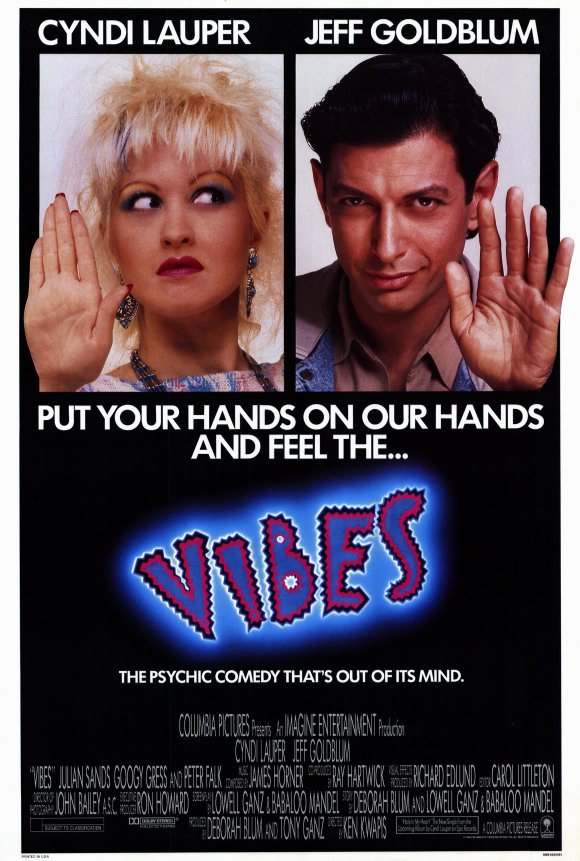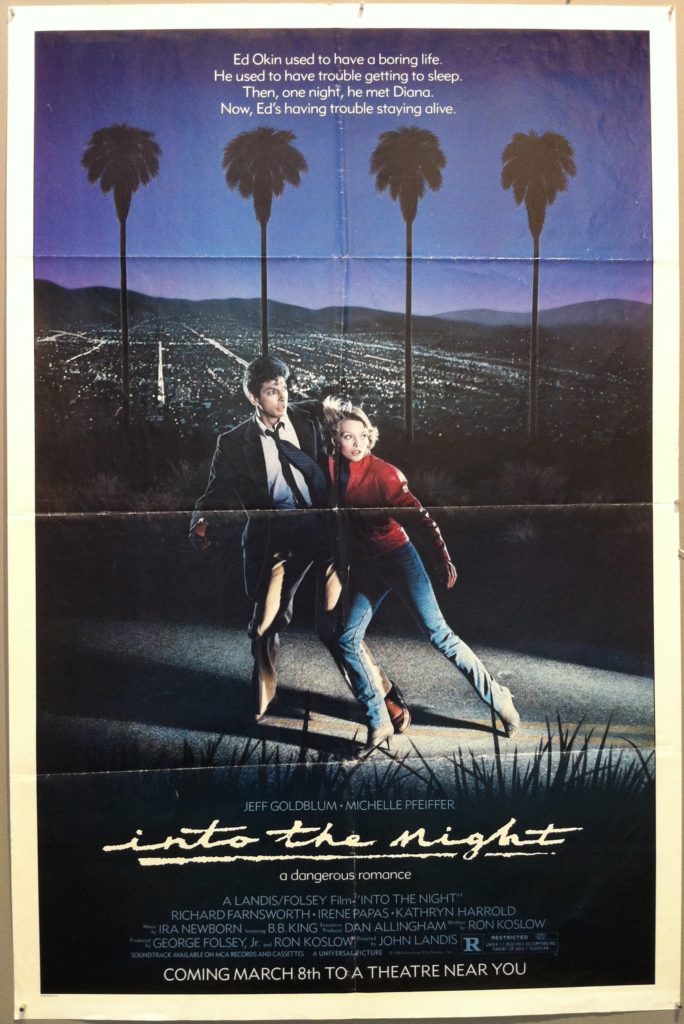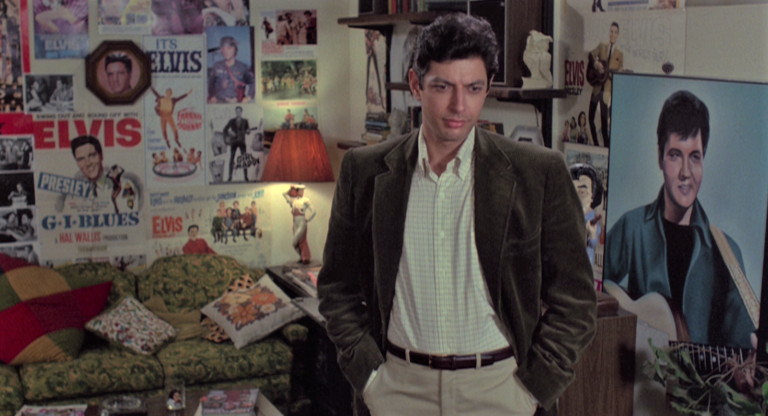
The charismatic but decidedly offbeat Jeff Goldblum has by now threatened to shift in public perception from an accomplished, prolific actor into an enshrined collection of memes, but in the 80’s – before Jurassic Park, before Independence Day, and long before Thor: Ragnarok – Hollywood was still trying to figure out his unique charm and how to exploit it appropriately. At first he was the supporting player at whom audiences would smile with recognition – stealing scenes in Invasion of the Body Snatchers (1978), The Big Chill (1983), The Right Stuff (1983), and The Adventures of Buckaroo Banzai Across the 8th Dimension (1984). Then he was moved to center stage for films that required a “different” kind of leading man, the breakthrough being David Cronenberg’s The Fly (1986), in which he proved he could be both a sex symbol and a goop-laden grotesquerie. Somewhat lost amidst this transitional phase are two early experiments to make Goldblum a headliner, Into the Night (1985) and Vibes (1988). The former is a violent comedy-thriller from John Landis, the latter a PG-rated fantasy comedy. Both place Goldblum in a romantic leading role, though everyday rom-coms these are not.
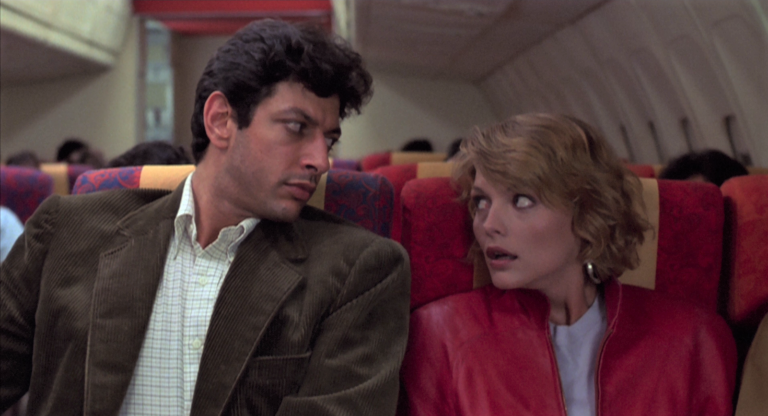
Jeff Goldblum and Michelle Pfeiffer try to hop a plane away from their troubles in “Into the Night.”
The former casts Goldblum as Ed Okin, an L.A.-based aerospace engineer suffering from insomnia and an existential crisis. He stares into space, he falls asleep at his desk, his marriage grinds forward, affectionate but dispassionate. His co-worker (Dan Aykroyd) suggests he run off to Vegas, recommending a call girl, a suggestion Ed dismisses. He’s missing something from his life, and it’s not sex. One day when he leaves work early to try to catch a nap at home, he discovers his wife in bed with another man. Rather than interrupt them, he drives off. Later that night, he doesn’t confront her. They watch TV. They have sex. Then, while she’s asleep, he gets up and leaves for the airport. In the parking garage, a woman lands on his car, pursued by armed Iranian hitmen. This is Diana (“like the Princess”), played by Michelle Pfeiffer. He saves her life, driving her out of the airport and into Los Angeles – and the film follows them through a sleepless night, visiting a Hollywood backlot, dashing through hotels, stealing a car from her Elvis impersonator brother, getting into car chases and gathering even more pursuers, including a grinning assassin played by David Bowie. Diana has smuggled into the country a collection of emeralds from the Shah of Iran, and everyone’s after them. As daylight breaks, Diana falls asleep – and Ed watches over her until the next night begins, and their adventures can resume; as though it couldn’t be any other way. (On the soundtrack, B.B. King performs the title song and “In the Midnight Hour.”) This is easily recognizable as a John Landis film, from the “See You Next Wednesday” in-joke (posters hung in the back of an actress’s trailer) to the nonstop parade of cameos, most of them from directors: future Goldblum employer David Cronenberg plays his boss here, and you can also see Paul Mazursky and Roger Vadim in prominent roles, with quick glimpses of Jim Henson, Paul Bartel, Jack Arnold, Amy Heckerling, Jonathan Demme, Jonathan Lynn, Lawrence Kasdan, Don Siegel, and Landis himself. A lovely supporting cast includes Irene Papas, Bruce McGill, Richard Farnsworth, and Vera Miles.
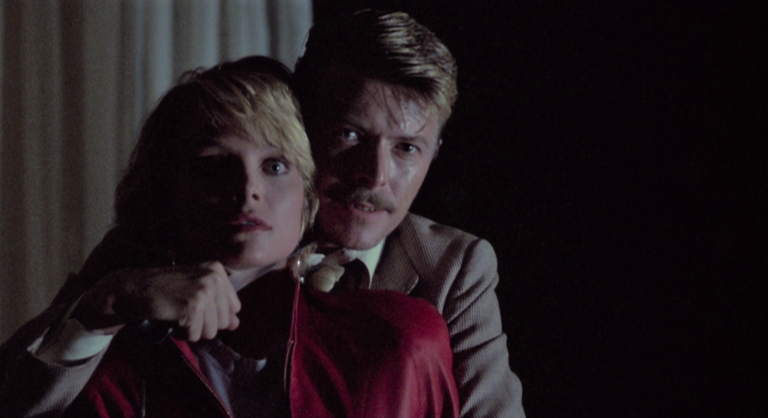
David Bowie, playing a professional killer, takes Pfeiffer as a hostage.
But if the plot reads as a light romantic caper – it is not. The violence is occasionally disturbing, particularly in the film’s climax; and some of the black comedy seems out of sync with the tone of the rest of the scene. I’m thinking in particular of the drowning of a woman on a beach, which is both nightmarishly shot while still making time for a visual joke. The joke is funny, but the laugh sticks in your throat quickly as the scene veers right back into horror. In Landis’s earlier An American Werewolf in London (1981), the comedy arises naturally out of the horror, working together organically. Here, the jokes sometimes feel like Landis couldn’t help himself – his forte is comedy – and there’s a tonal whiplash. If the comedy weren’t so silly, it might clash less. And yet there’s a lot here to like. To a modern viewer more accustomed to Goldblum being cast for camp value, it’s fascinating to see his performance in Into the Night – he underplays everything. Ed Okin is a man whose life has come apart, who doesn’t know what he should do next – when his obligations to the damsel in distress are completed, he drifts back to her again, because he has nowhere else to go and because his life has been stripped of any other purpose. We can also see that he’s attracted to Diana and curious about her – even though she doesn’t seem to be terribly curious about him, taking his devotion somewhat for granted. (This trait is remarked upon by other characters.) The film rests on the inherent likability of Goldblum and Pfeiffer, and its confidence is well placed. These are two you would want to spend the whole night with. The film anticipates two takes on similar material: Martin Scorsese’s great After Hours (1985) and Jonathan Demme’s Something Wild (1986), and it’s one of a number of 80’s films commenting on Yuppie discontent, the best of which might be Albert Brooks’ merciless satire Lost in America (1985). But something about Into the Night feels damaged, which is not entirely a criticism; despite its occasional miscalculations, the film’s inherent sadness sticks with me. (There’s a happy ending here, but it’s easy to forget that it has one.) In fact, it is not until I’ve started writing this that I’ve realized the film’s real topic is depression. And I can’t help but speculate if Landis’s life off the set was leaving a mark on the material – in the middle of filming, he stood trial for involuntary manslaughter for the tragic accident on the set of Twilight Zone: The Movie. Something, at any rate, hangs over Into the Night like a dark cloud. Looking back on it these decades later, it’s a fascinating movie. Scream Factory released the film as part of its Shout Select series in 2017.
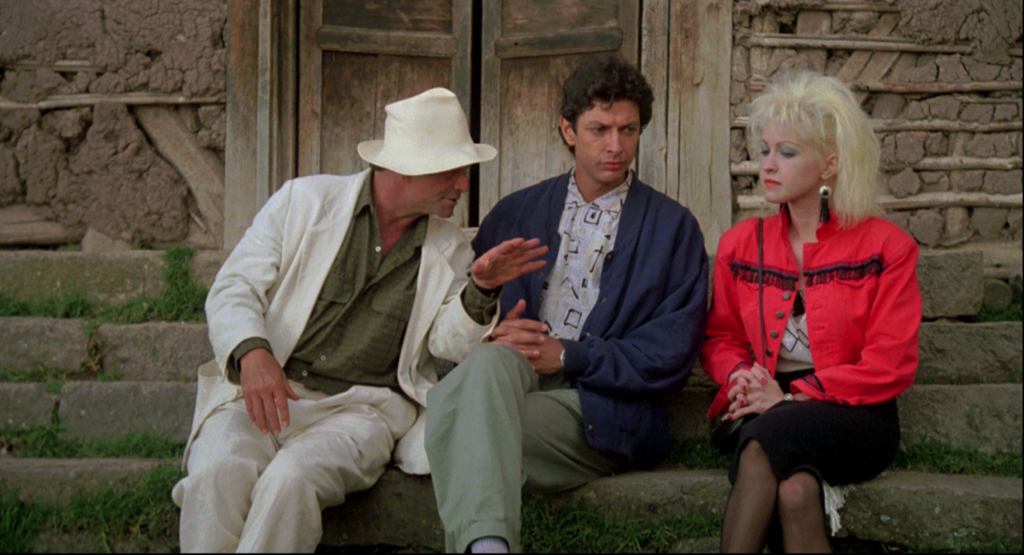
Peter Falk and Cyndi Lauper join Goldblum for “Vibes.”
To end this double feature on a lighter note, we have the supernatural romantic comedy Vibes, recently released from Mill Creek as part of their line of Blu-rays made to look like VHS boxes – appropriate, because I hadn’t thought about Vibes since the VHS era. (I actually saw this one in the theater, but still barely remembered a thing about it.) Clearly taking inspiration from Ghostbusters (1984), Vibes leans into its fantasy elements, opening with explorers in Ecuador uncovering a glowing artifact of psychic energy which quickly consumes all of them. We then cut to a psychic study program led by Dr. Harrison Steele (Julian Sands), whose star students are Nick Deezy (Goldblum) and Sylvia Pickel (Cyndi Lauper). (As in Ghostbusters, we see psychic subjects undergoing an exam with ESP cards. But here there’s no sleazy angle.) Anything Nick touches gives him an instant history of the object, to comic effect. Sylvia relies on an invisible spirit guide named Louise, with whom she’s constantly in conversation. At the outset, Louise informs Sylvia who informs Nick that Nick’s wife is having an affair. That night, he gains confirmation when he touches her panties. Yes – once again Goldblum is the cuckold. But Nick Deezy is more recognizably a “Goldblum” characterization than the reserved Ed Okin; anyone looking for his left-field line readings will be rewarded by Vibes. Pairing Goldblum with eccentric pop star Lauper, in her acting debut, says something about what the producers were after – goofy, in a word. But they’re smartly matched with Peter Falk, in full In-Laws mode, as Harry Buscafusco, who telegraphs “shady character” while paying them in a large wad of cash to find his lost son, “Harry Jr.,” in Ecuador. Of course there is no Harry Jr. – he’s really trying to locate a lost city and its treasure, hoping their psychic powers will point the way. He’s not the only one with this scheme.
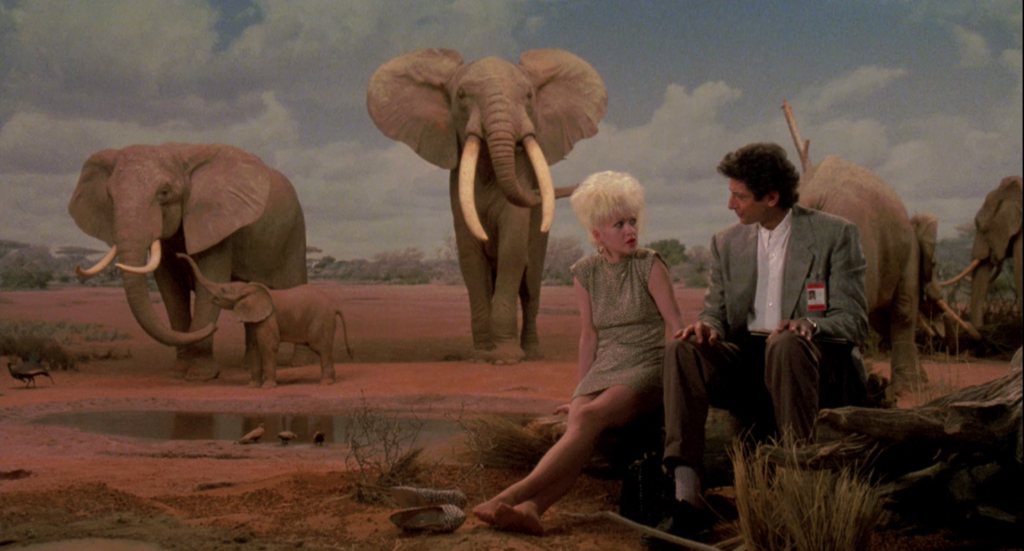
Getting to know one another.
Having not seen this since I was young, I had no expectations for its quality. I’m pleased to report it’s a lot of fun. The screenplay, by Lowell Ganz and Babaloo Mandel (writers of Splash and Parenthood), is efficiently structured and finds a natural comic spark among its three central mismatched characters, which Falk and Goldblum exploit to the hilt. As for Lauper, who gets top billing – would you believe she’s pretty good? I am sure many will find her Bronx take on this earthy, lovelorn psychic grating; it’s certainly an unconventional choice for “female romantic lead.” But her performance walks a tightrope, balancing the brash and the loud (mostly referring to her fashion sense here) with a genuine vulnerability. She lets us know with her eyes that Sylvia is deeply lonely, dependent entirely on her invisible friend. She throws herself at men – including, at one point, Steve Buscemi – hoping that one of them, eventually, will catch her, which creates a genuinely sexy dance between her and Goldblum’s character. (They do share a literal dance, a brief tango in which the height difference between the actors becomes a visual gag.) If there’s a theme uniting the films in today’s double feature, it’s loneliness, and there’s a touching moment when Sylvia realizes that Louise has left her for good – for the first time in a long time, she’s on her own.
Vibes is no major re-discovery. A few major comic setpieces would make this a minor classic, but I’m writing about this movie the next morning and can’t think of a single one. Mostly, it’s just a pleasurable journey with a fun cast, heightened by touches of fantasy. The special effects, mostly in effect when they finally reach the lost Incan city, are by Richard Edlund, who worked on Ghostbusters – but don’t expect much (the budget is low). Mostly I enjoyed the location shooting in Ecuador, the South American soundtrack, the bright and funny script, and the always unpredictable interactions between Goldblum and Lauper. There is a genuinely horrible final gag before it cuts to the end credits – but we still end this double feature on pretty good Goldblum vibes.
